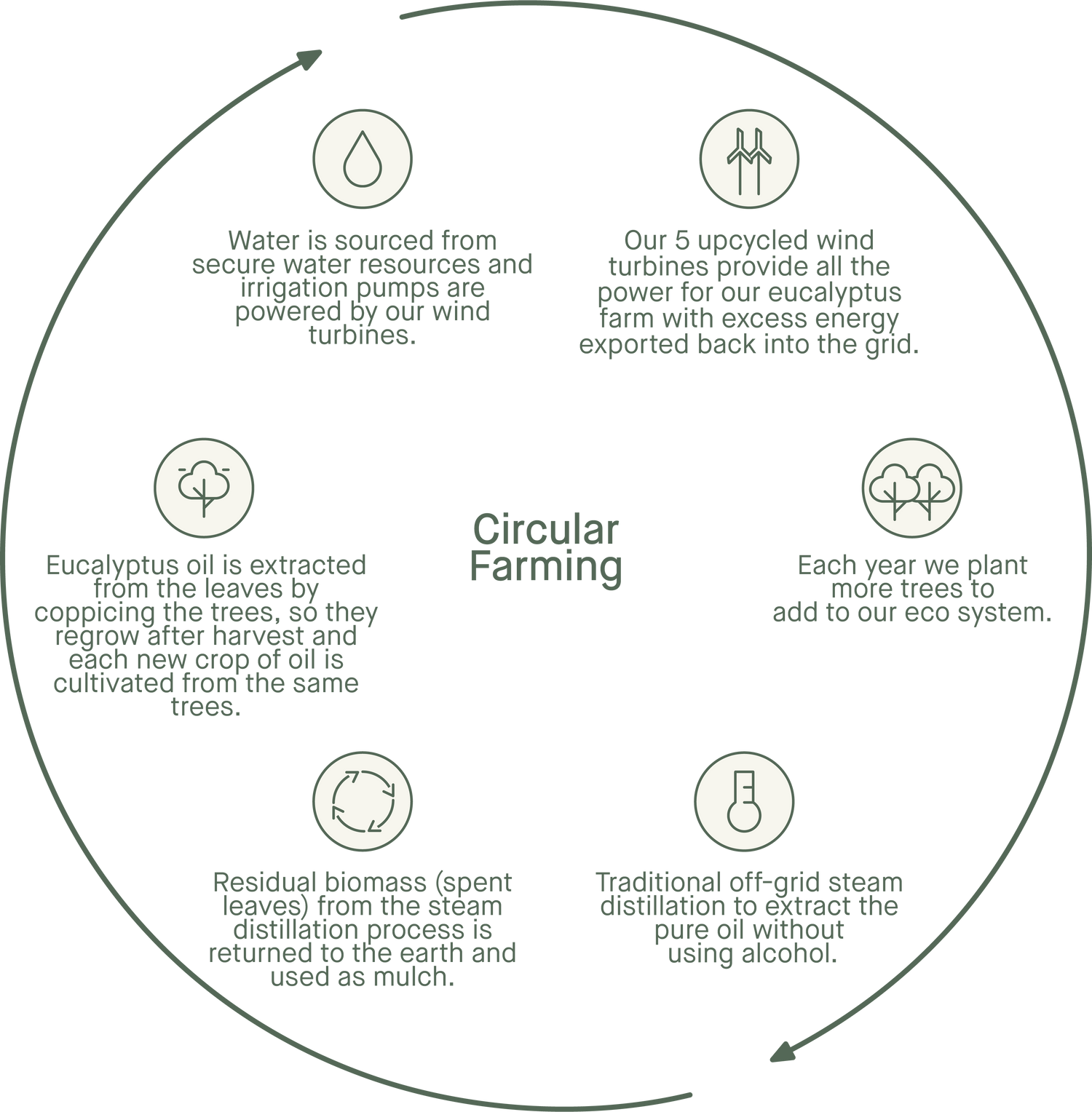The Give Back: Regenerative farming
Share information about your brand with your customers. Describe a product, make announcements, or welcome customers to your store.

Regenerative Farming
By growing these native plants in Western Australia and Eastern Australia using sustainable & regenerative farming practices, it was important that we consider how this care for the environment travels through every facet of our business practices.
Over 4,274 hectares we propogate and farm sixty million tea trees and 1.6 million Blue Mallee trees. ETTO's planting program establishes three million new Tea Tree every year and has installed five wind turbines to power our eucalyptus farm which means our steam extracted Blue Mallee eucalyptus lives an 100% off grid lifestyle.
Taking our environmental certification for sustainability seriously, we work with eco-environmental groups and local universities to monitor and sustain our land, supporting the neighbouring pristine national forest full of native flora and fauna as well as the surrounding creeks and lagoons.
ETTO Blue Mallee Eucalyptus Versus Globulus
The main naturally occurring competent of ETTO Blue Mallee (Eucalyptus polybractea) is cineole which research has demonstrated has anti-inflammatory properties. ETTO oil contains 84% cineole compared to the commonly used Eucalyptus globulus which typically only contains around 60%. The below table shows results from our latest independent lab test results indicating the level of cineole in our Blue Mallee.
Soil To Oil
We use traditional steam distillation methods to extract the oils from the plands, so no chemiclas are used, and the spend leaf is returned back to the earth as mulch. We own and operate the farm product the raw ingredient, formulate and bottle the end product.
Fly Over Etto Australia Farms
something about video here?
We use traditional steam distillation methods to extract the oils from the plands, so no chemiclas are used, and the spend leaf is returned back to the earth as mulch. We own and operate the farm product the raw ingredient, formulate and bottle the end product.
As a company that is owned and basked in Australia, we aim to manufacture our products in the country too. All are proudly made and filled by local Australian companies, except for our converted micro-dart pimple patches which are made in South Korea, due to technological advances unavailable in Australia to date.
Wherever possible, we always use post-consumer recycled plastic, minimal recyclable packaging and postage that reduces the carbon footprint.
Multicolumn
-
Oil Adulteration
The fast-growing Tasmanian Blue Gum (Eucalyptus globulus) is now predominantly grown in Asia and this market has more or less had a monopoly on Eucalyptus oil production. The rise of globulus oil production in Asia came about because it was a natural by-product of the large-scale timber and pulpwood industry happening there.
Over the last couple of decades, a growing interest in sustainability and traceability of source ingredients by consumers and global industries generally, has seen a return of looking to Australia as the natural source of Eucalyptus oil. There are a few varieties that are predominantly used for oil includingEucalyptus globulus(blue gum),Eucalyptus radiataandEucalyptus dives(peppermint eucalyptus). In a first to industry, ETTO Australia steam distils the varietyEucalyptus polybractea (Blue Mallee)for its cineole content is much higher making it a superior and more potent therapeutic botanical. Common globulus will often only contain around 60% cineole, and radiata and dives even less at around 40%, whereas ETTOpolybracteacontains 84% cineole.
-
Steam Distilled
Further, because the International standards require all commercially traded eucalyptus oil must have a minimum content of 1,8-cineole of 70%, steam extracted globulus must be "rectified" to inhance it's cineole levels.
-
Rectification
Rectification involves a low temperature vacuum distillation of the oil that removes some of the other components in eucalyptus like pinene and sabinene which in turn increases the concentration of remaining cineole.
